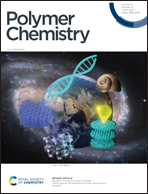Supramolecular AIE polymer-based rare earth metallogels for the selective detection and high efficiency removal of cyanide and perchlorate†
Abstract
Two novel supramolecular AIE polymer-based rare earth metallogels (PT-GEu and PT-GTb) were rationally designed and synthesized for the efficient detection and separation of cyanide (CN−) and perchlorate (ClO4−). PT-GEu and PT-GTb were prepared by introducing Eu3+ and Tb3+ into a novel supramolecular polymer (PT-G), which was constructed by the assembly of o-phthalimide functionalized pillar[5]arene host PM and tri-amide guest TH. The supramolecular polymer PT-G shows strong yellow aggregation-induced emission (AIE). Interestingly, after coordination with Eu3+ or Tb3+, the obtained AIE polymer-based rare earth metallogels (PT-GEu or PT-GTb) show “turn-off” AIE. Interestingly, PT-GEu and PT-GTb exhibit selective and sensitive fluorescent “turn-on” recognition for CN− and ClO4−, respectively. The lowest detection limits are 3.36 × 10−6 M for ClO4− by PT-GEu and 5.96 × 10−8 M for CN− by PT-GTb. In addition, the xerogel of PT-GEu and PT-GTb shows nice separation properties for ClO4− and CN−, the adsorption rate of these rare earth metallogels for ClO4− and CN− reached up to 92.86% and 93.33%. Moreover, ion detection test kits were prepared based on these rare earth metallogels, which rapidly detect CN− and ClO4−.



 Please wait while we load your content...
Please wait while we load your content...